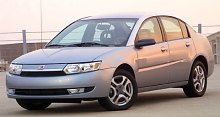 In
the 80s, Japanese dominated the American small car market. To strike
back,
GM decided to set up a new division called Saturn, building small cars
using new engineering, marketing and production methods never tried
before
by any American car makers. The first Saturn, S-series, went into
production
in 1990, taking place at a brand new factory in Tennessee. It had a
sophisticated
look, 16-valve engine and plastic body panels to made it headlines in
automotive
magazines. The result? after 13 years, one major renew, 1 mid-life
makeover,
the American small car never really took off. Corolla and Civic - now
enter
the European-designed Ford Focus - still dominate the small car
segment.
The Saturn only succeeded to keep its customers satisfying (as shown in
JD Power surveys) thanks to its good customer services. In
the 80s, Japanese dominated the American small car market. To strike
back,
GM decided to set up a new division called Saturn, building small cars
using new engineering, marketing and production methods never tried
before
by any American car makers. The first Saturn, S-series, went into
production
in 1990, taking place at a brand new factory in Tennessee. It had a
sophisticated
look, 16-valve engine and plastic body panels to made it headlines in
automotive
magazines. The result? after 13 years, one major renew, 1 mid-life
makeover,
the American small car never really took off. Corolla and Civic - now
enter
the European-designed Ford Focus - still dominate the small car
segment.
The Saturn only succeeded to keep its customers satisfying (as shown in
JD Power surveys) thanks to its good customer services.
GM admits the defeat, but it won’t give up so early (by the way, it already gave Oldsmobile 100 years to prove itself). Here comes its third generation attempt - Saturn Ion. In mechanical aspect, Ion has taken a big leap forward. It is built on GM’s new global platform Delta, which will give birth to the next generation Opel Astra as well. The Delta was developed in Germany, therefore you can trust its chassis stiffness and NVH suppression. Its rear wheels ride on torsion-beam axle in European way, unlike the trailing-arms of the S-series.
Engine is the familiar Lotus-developed Ecotec 2.2-litre 16-valve four-cylinder, with twin-balancer shafts to ensure smooth and linear power delivery. This is a world class engine, and probably the only item better than its competitors. 140 horsepower and 145 lbft of torque is class-leading too, although it also drink more fuel than its 1.8 or 2.0-litre counterparts. Another surprise is the adoption of an automatic transmission with 5 ratios and a CVT gearbox taken from Saturn VUE, beside that standard 5-speed manual. Does the high specifications deliver in real world? not really. Despite of big engine and 5-speed automatic gearbox, Ion takes 10.2 seconds to reach 60mph, a second off from my prediction beforehand. Its top speed is electronically limited at 107mph. This is quite disappointing for a 2.2-litre small car weighing 1255kg. Handling is tidy enough but not very interesting. Steering feel is lifeless, while the electrical assistance is artificially non-linear. The new suspensions and rigid chassis deal with bumps pretty good, providing a much smoother and quieter ride than the outgoing S-series. Braking is also up to the job. Overall speaking, Ion is easy to live with but it is also rather boring to drive.
Space and comfort aren’t remarkable too. The front passengers enjoys good room, but the seats are flat, unsupportive and uncomfortable. At the rear, both headroom and legroom are less than its rivals like Civic, Corolla and Focus. So, at least the
price is
cheaper than its rivals? no. Saturn Ion is actually no cheaper than the
aforementioned rivals in the USA. So, you can forget this car as if it
were never existed. One day, if you read news about its disappointing
sales,
its plant closure or even the termination of the Saturn division, you
need
not to be surprised. This is the American way of starting and ending a
dream. |
| The above report was last updated on 3 Mar 2003. All Rights Reserved. |
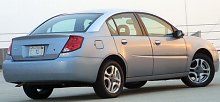 Although
Delta has a conventional steel monocoque chassis, the Saturn version is
covered with polymer plastic doors, fenders and rear quarter panels in
traditional way for the benefit of dent-resistant and easy replacement
in case of damage. Customers can also choose different colors of roof
rails,
this is probably learned from Smart city car. In terms of size, the Ion
matches the latest generation of European hatchback in wheelbase and
exceeds
them by a large margin in overall length, thanks to its 3-box
structure.
The trunk offers an astonishing 520 litres of luggage space.
Although
Delta has a conventional steel monocoque chassis, the Saturn version is
covered with polymer plastic doors, fenders and rear quarter panels in
traditional way for the benefit of dent-resistant and easy replacement
in case of damage. Customers can also choose different colors of roof
rails,
this is probably learned from Smart city car. In terms of size, the Ion
matches the latest generation of European hatchback in wheelbase and
exceeds
them by a large margin in overall length, thanks to its 3-box
structure.
The trunk offers an astonishing 520 litres of luggage space.
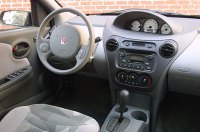 So
far, this could have been a 3-star (read "average") car. Unfortunately,
Ion loses most of its hard-earned stars by its cabin. There, you will
see
an unbelievably cheap, ugly and odd-looking environment. The instrument
readings are positioned right over the center console instead of the
usual
place in front of the driver. That’s not a problem, as Toyota also does
this in its Yaris, but the design in Ion is really too bad. Look at
that
instrument panel! look at that center console! look at that steering
wheel!
look at their strange shape and all those rough, 1970’s kind of plastic
materials. They suddenly make Korean cars luxurious. Running over rough
surfaces, you can hear creaks and rattles coming out of the poor fit of
plastic panels. Now you wonder how GM could spend a lot of money into
the
chassis and then decided to save the same amount of money from the
interior.
Despite of Bob Lutz, this is still very much an accountant-driven
company,
sadly.
So
far, this could have been a 3-star (read "average") car. Unfortunately,
Ion loses most of its hard-earned stars by its cabin. There, you will
see
an unbelievably cheap, ugly and odd-looking environment. The instrument
readings are positioned right over the center console instead of the
usual
place in front of the driver. That’s not a problem, as Toyota also does
this in its Yaris, but the design in Ion is really too bad. Look at
that
instrument panel! look at that center console! look at that steering
wheel!
look at their strange shape and all those rough, 1970’s kind of plastic
materials. They suddenly make Korean cars luxurious. Running over rough
surfaces, you can hear creaks and rattles coming out of the poor fit of
plastic panels. Now you wonder how GM could spend a lot of money into
the
chassis and then decided to save the same amount of money from the
interior.
Despite of Bob Lutz, this is still very much an accountant-driven
company,
sadly. 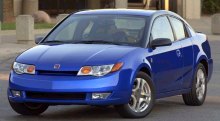 When
a coupe is devoid of speed and excitement, it becomes nothing.
When
a coupe is devoid of speed and excitement, it becomes nothing.
 This
feeling of being cheated vapours in the cabin. The dashboard, console
and
seats are unchanged from the sedan. That means horrible taste,
rubbish-grade
quality and uncomfortable seats. With a pair of RX-8-style rear-hinged
doors and the elimination of B-pillars, the rear passengers may be
better
catered than in other coupes, but then it cannot accommodate my 5' 10"
frame.
This
feeling of being cheated vapours in the cabin. The dashboard, console
and
seats are unchanged from the sedan. That means horrible taste,
rubbish-grade
quality and uncomfortable seats. With a pair of RX-8-style rear-hinged
doors and the elimination of B-pillars, the rear passengers may be
better
catered than in other coupes, but then it cannot accommodate my 5' 10"
frame. 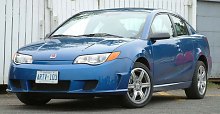 Although
Ion is one of the poorest new cars we encountered in recent years, its
fault is more about finishing instead of fundamental. Remember, its
basis
is GM’s Delta platform, which is closely related to the new Opel Astra.
The stiff chassis offers tidy handling and refined ride like European
cars.
What it lacks is a decent powertrain and a sharp chassis response. Ion
Red Line is going to deal with these problems.
Although
Ion is one of the poorest new cars we encountered in recent years, its
fault is more about finishing instead of fundamental. Remember, its
basis
is GM’s Delta platform, which is closely related to the new Opel Astra.
The stiff chassis offers tidy handling and refined ride like European
cars.
What it lacks is a decent powertrain and a sharp chassis response. Ion
Red Line is going to deal with these problems.